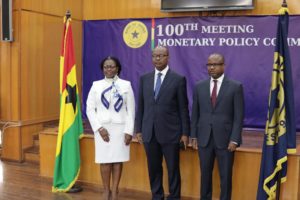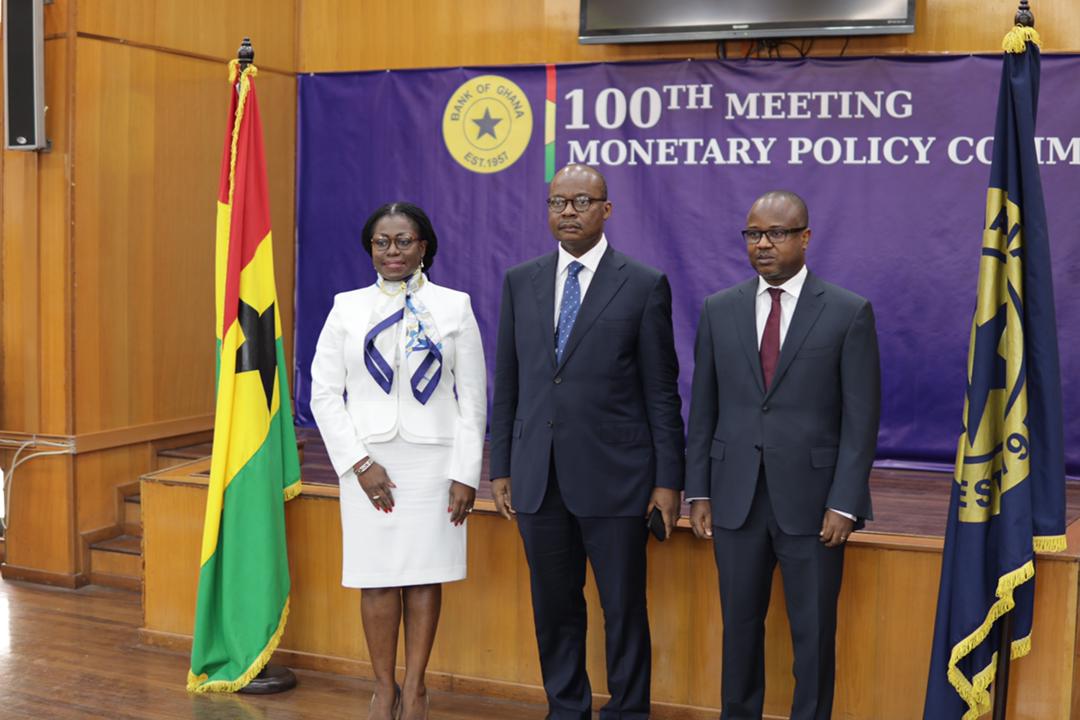
Accra, Ghana//-In his review of the economy in parliament in 2003, Yaw Osafo Maafo, the then Minister of Finance described the gap between Bank of Ghana (BoG) and the lending rates of the commercial banks to be unacceptably high.
In 2021, the senior advisor to the President of Ghana and my fellow Akora from Achimota again, in his address to the gathering at the 2021 Ghana Industrial Summit and Exhibition in Accra, called on banks to reduce their lending rates.
His call at the Summit was mainly based on the fact that factors such as exchange rate, inflation and prime rate that affect the cost of lending rates have been on a decline due to the banking sector reforms.
Therefore, the reforms have addressed the inherent risk elements of commercial banks’ lending, and as such, the interest rate and the BoG policy rate gap should be narrowed.
He is absolutely right.
The Monetary Policy Committee (MPC) of BoG sets the prime rate, which various commercial banks and other financial institutions also operate with in Ghana.
This influences the commercial banks’ lending rates. It serves as a benchmark used to signal the cost of funds, which is expected to be transmitted throughout the financial system, as banks reflect it in transactions among themselves and with the general public.
The degree of transmission of the policy rate depends on the degree of development and competition in the financial system. However, in Ghana, the transmission of the policy rate through the lending rates of the individual banks has been extremely tardy (Kwakye, 2010).
In as much as the decline in the BoG’s policy rate is a major determinant of the lending rates of the commercial banks in Ghana, other facts equally exert significant influence on the lending rates of commercial banks. Notable among them is the commercial banks’ Minimum Reserve.
The commercial banks’ Minimum Reserve is the percentage of deposits commercial banks must be retained as a backup.
The BoG also determines this, such that whenever it makes an upwards adjustment of the commercial banks’ reserve, the amount of money available to the banks to lend to their customer is reduced.
Professor Joshua Yindenaba Abor is a qualified accountant, financial economist and Professor of Finance with a lot of years’ expertise mainly in economics research and development finance.
Prof Abor (2004) asserts that the commercial banks’ Minimum Reserve requirement eventually leads to an increase in interest rate.
It safes to suggest that the impact of the increase in the minimum capital requirement for commercial banks from GH¢ 120 million toGH¢ 400 million by the BoG is one of the reasons why the lending rate is still high.
The central premise of the call of Mr Maafo is the impact of the banking sector clean-up exercise. He believes that the reform has reduced the risk elements of commercial banks’ lending.
One of the indicators of this risk element is the non-performing loan ratio (NPL), which measures the effectiveness of a bank in receiving repayments on its loans.
The 2020 BoG Banking Sector Report indicates that the NPL ratio was 18.4% at the end of 2018, this declined to 14.3% in 2019 due to the reforms. However, the NPL ratio at the end of 2020 began to rise again due to real non-recovery of credit.
Since this is a ratio, it is possible that the total amount of outstanding loans the bank holds is increasing whilst the amount of non-performing loans in a bank’s loan portfolio remains unchanged, causing the ratio to increase.
Also, the fact that the non-performing loan ratio has declined does not necessarily mean that the value of the non-performing loans has declined.
Would you say that the period after the clean-up exercise represents a feasible time space to perform a cost-benefit analysis for lending rate declines?
It is important to interrogate whether the banking sector clean-up has really reduced the risk element of commercial banks’ lending.
The reforms came with some cost – some GH¢ 21billion was spent by the government on the clean-up. This is the reason for the introduction of a new 5 percent financial sector clean-up levy in the 2021 budget.
The levy is expected to help provide the money to pay for outstanding commitments in the sector and is projected to run until 2024 and be reviewed after that.
This could be one of the reasons why commercial banks are dragging their feet in reducing their lending rates. Since the banks are in the business of making a profit, they will shift the cost on the borrowers, causing their lending rates and other charges to be high.
Additionally, the clean-up also reduced the number of banks from 34 to 23. At the same time, 347 micro-finance institutions, 15 savings and loans, and eight finance houses had their licenses revoked.
Kwakye (2010) asserted that the degree of transmission of the policy rate depends to a large extent on the degree of competition in the financial system. Therefore, the decline in the number of banks and financial institutions will impact the competition in the banking sector.
One possible implication of this decline in the number of in the number of banks and other financial institutions in Ghana now is that it prevents commercial banks from decreasing their lending rates.
The immediate impact of the reduction in the number of banking institutions imposes a constraint on credit accessibility, interest rate, and credit rationing (Maiti et al., 2020).
According to Boamah (2019), the expectation is that competition of the commercial banks for customers will result in a substantial fall in their lending rates. However, the contrary is true in the case of Ghana as Mr Maafo has stated recently.
The truth is, while increased competition in the banking sector in Ghana did not lead to a low lending rate, a reduction in competition through the clean-up exercise will not result in a fall in lending rates even with the declining monetary policy rate, not without some intervention by the powers that be.
Also, the traditional theory posits that demand and supply forces are responsible for determining the interest rate of loanable funds.
It implies that the interest rate is determined by demand and supply forces that are non-monetary and not by monetary factors such as the monetary policy rate.
It does not attribute the responsibility of interest rate determination to neither the commercial banks nor the central bank’s MPR (Boamah, 2019; Tsiang, 1980).
Therefore an increased demand for capital credit or loans will cause the banks to increase the rate to segregate down demand so that those that can afford it will go for it (Abor & Biekpe, 2007; Diamond, 1984).
Based on the normal demand and supply analysis, a rise in demand for credit from the banks puts demand pressure on the commercial banks to charge high rates. As a result, the gap between the BoG’s policy rate and the lending rate will tend to be high.
Furthermore, the banks in Ghana charge high lending rates due to the information asymmetry problem. The commercial banks set these rates high in an attempt to offset higher risks resulting from asymmetric information (Maiti et al., 2020).
Similarly, (Asamoah & Adu, 2016) attribute the high rate of interest in Ghana to imperfections in the financial market due to asymmetric information.
Researches since the 1980s have always found the existence of information asymmetry in Ghana’s financial system (Stiglitz & Weiss (1981). They assert it is responsible for the inefficiencies in the financial sector.
The majority of the businesses, customers, and those who seek credit from the commercial banks do not have the requisite information and are not aware of what the central bank charges.
Because of the information limitation, they are unable to adequately negotiate for a reduction in the rate and tend to take what the commercial banks offer them.
Also, the cause of the high lending of the commercial banks can be looked at from a speculative point of view. Sometimes banks will want to attract more investors in their commercial assets rather than the state assets by increasing their interest rate.
This also explains why there is a gap between the lending rate of the commercial banks and the prime rate of the central bank.
According to Lartey (2018), there is a positive relationship between average lending rates and monetary policy rates (MPR) in Ghana. Although the result was that MPR was significant in both the short run and long run, the speed of adjustment was relatively slow in the short run. This implies there are some other factors, like those stated above, that are responsible for the upward adjustment of commercial lending rate towards the BoG’s prime rate.
Moreover, studies have also shown that developing countries tend to experience weaker transmission of monetary policy shocks to bank lending rates (Mishra et al., 2014).
According to the study just aforementioned, countries with better institutional frameworks, more developed financial structures, and less concentrated banking systems tend to have stronger transmission of monetary policy shocks to bank lending rates.
Developing economies compared to developed economies score poorly along all of these dimensions.
In summary, in as much the policy rate of the BoG has a major influence on the lending rate of the commercial banks. It is not the only factor that determines the interest rate. The factors discussed above also play a vital role in the movement of the lending rate of the commercial banks in Ghana.
Therefore, something must be donein addressing these challenges. The sector clean-up exercise has its merits. Nonetheless, calling on commercial banks alone to reduce lending rates might not be enough as financial institutions, like banks, tend to operate as a private business prioritising profit.
If nothing more is done about the increasing lending rates, in the end, it is the citizens that suffer.
By Maxwell Ampong

Maxwell Ampong is the CEO of Maxwell Investments Group. He is also the Official Business Advisor to the largest trade union in Ghana, the General Agricultural Workers Union (GAWU) of TUC Ghana. He writes about trending and relevant economic topics, and general perspective pieces.


